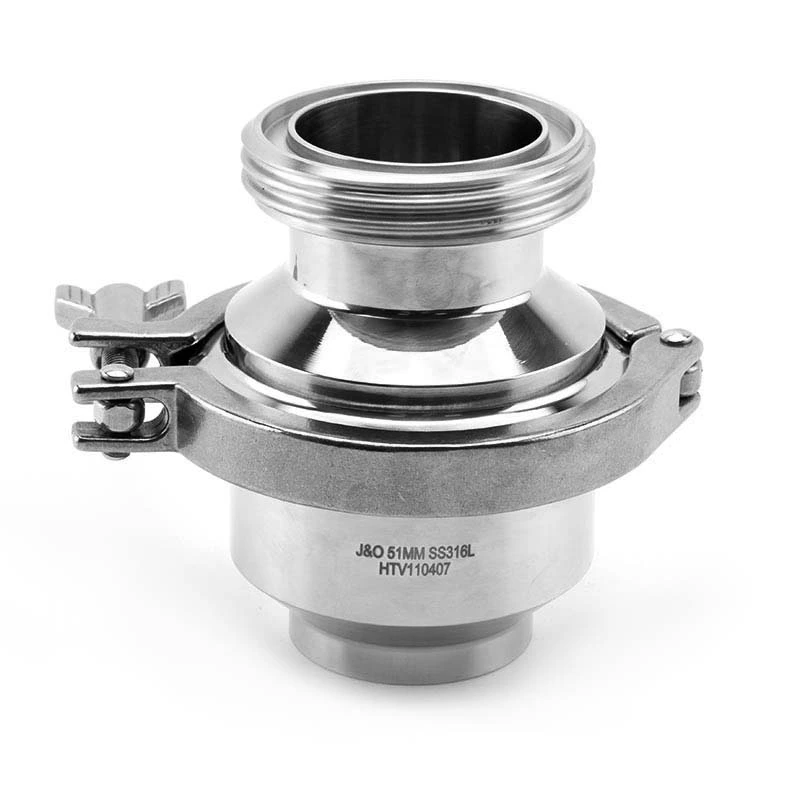Basic Knowledge Of Sanitary Check Valve Types, Working Principles, And Functions
A Sanitary Check Valve, also known as a non-return valve, allows fluid flow in a fixed direction while automatically preventing reverse flow (backflow). It is a self-closing valve with a disc or rocker plate within the valve body. When the fluid flows forward, the disc automatically opens; when the fluid flows backward, the fluid (or spring force) automatically closes the disc.
The disc of a lift check valve rises and falls perpendicular to the valve body passageway and is generally used in horizontal or vertical pipes. The disc of a swing check valve, often called a rocker plate, is connected to a shaft on one side and can rotate about the axis. Swing check valves are generally installed in horizontal pipes, but smaller diameters can also be installed in vertical pipes, but care should be taken to minimize excessive flow rates.
Check valves are generally suitable for pipelines carrying clean media and are not suitable for pipelines containing solid particles or high-viscosity media. Lift check valves offer better sealing performance than swing check valves, but they also have lower fluid resistance than lift check valves. Swing check valves are generally suitable for large-diameter pipes. Check valves are classified by their structure into lift check valves, swing check valves, axial flow check valves, butterfly check valves, and other specialized check valves.
1. Swing Check Valve
The disc of a swing check valve is disc-shaped and rotates around the axis of the valve seat passage. Due to the streamlined flow path within the valve, the flow resistance is lower than that of a lift check valve. It is suitable for large-diameter applications with low flow rates and infrequent flow fluctuations. However, it is not suitable for pulsating flows, and its sealing performance is inferior to that of a lift check valve. Swing check valves are categorized into single-disc, double-disc, and multi-disc types. These types are primarily categorized by valve diameter. Their purpose is to mitigate hydraulic shock when the medium stops flowing or flows backward.
2. Lift Check Valve
A lift check valve's disc slides along the vertical centerline of the valve body. A spherical disc may be used on high-pressure, small-diameter check valves. The body shape of a lift check valve is the same as that of a globe valve (and is interchangeable with both), resulting in a higher fluid resistance coefficient. Its structure is similar to that of a globe valve, with the same valve body and disc. Guide sleeves are machined into the upper disc and lower bonnet, allowing the disc to rise and fall freely within the bonnet guide. When the medium flows forward, the disc opens due to the medium's thrust. When the medium stops flowing, the disc descends onto the valve seat due to its own weight, preventing reverse flow.
3. Axial Flow Check Valve
With the construction and expansion of large-scale domestic refining and ethylene petrochemical projects, demanding check valves with fast closing speeds, low pressure drop, and low noise levels are increasingly required for long-distance oil and gas pipeline systems and large ethylene plants, where compressors and large pumps operate under demanding operating conditions. This is especially true for gaseous media. Conventional swing and double-plate check valves often fail to fully open, resulting in unstable flow, high pressure drop, mechanical vibration, and high noise levels, which can affect the normal operation of large compressors and pumps. Therefore, specialized axial flow check valves are required to ensure the safe and efficient operation of these equipment and pipeline systems. 4. Butterfly Check Valve
Butterfly check valves can be installed in any position and can be installed on horizontal, vertical, or inclined pipelines.
Micro-resistance, slow-closing butterfly check valves consist primarily of a valve body, two semicircular discs, a return spring, an oil reservoir, a slow-closing small cylinder assembly, and a needle valve (micro-regulating valve). They can be used in drainage pipes carrying media such as clean water, sewage, and seawater. They prevent backflow and effectively limit destructive water hammer, ensuring pipeline safety. They are not suitable for media containing solid particles or high-viscosity particles. They are small, lightweight, and only about one-third the length of a swing check valve.
This article focuses on check valves installed on the outlet side of steam traps.
Spring-disc check valves
Spring-disc valves have a very low opening and closing pressure differential, resulting in a tight seal. Once backpressure occurs, the valve closes immediately.
